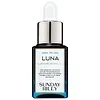What's inside
What's inside
 Key Ingredients
Key Ingredients

 Benefits
Benefits

 Concerns
Concerns

 Ingredients Side-by-side
Ingredients Side-by-side

Helianthus Annuus Seed Oil
EmollientOlea Europaea Fruit Oil
MaskingCaprylic/Capric Triglyceride
MaskingSimmondsia Chinensis Seed Oil
EmollientSqualane
EmollientDimethyl Isosorbide
SolventAscorbyl Tetraisopalmitate
AntioxidantHeptyl Undecylenate
EmollientTocopheryl Acetate
AntioxidantHydroxypinacolone Retinoate
Skin ConditioningTocopherol
AntioxidantSqualene
EmollientGlycine Soja Oil
EmollientBeta-Sitosterol
Emulsion StabilisingTriticum Vulgare Seed Extract
BufferingHelianthus Annuus Seed Oil, Olea Europaea Fruit Oil, Caprylic/Capric Triglyceride, Simmondsia Chinensis Seed Oil, Squalane, Dimethyl Isosorbide, Ascorbyl Tetraisopalmitate, Heptyl Undecylenate, Tocopheryl Acetate, Hydroxypinacolone Retinoate, Tocopherol, Squalene, Glycine Soja Oil, Beta-Sitosterol, Triticum Vulgare Seed Extract
Vitis Vinifera Seed Oil
EmollientRubus Laciniatus Seed Oil
Skin ConditioningSalvia Hispanica Seed Oil
MoisturisingPersea Gratissima Oil
Skin ConditioningDimethyl Isosorbide
SolventHelianthus Annuus Seed Oil
EmollientHydroxypinacolone Retinoate
Skin ConditioningRosmarinus Officinalis Leaf Extract
AntimicrobialCitrus Aurantium Amara Flower Oil
MaskingCitrus Aurantium Dulcis Oil
MaskingChamomilla Recutita Flower Oil
MaskingCananga Odorata Flower Oil
MaskingVetiveria Zizanoides Root Oil
MaskingAnthemis Nobilis Flower Oil
MaskingTanacetum Annuum Flower Oil
MaskingVanilla Planifolia Fruit Extract
Skin ConditioningEriocephalus Punctulatus Oil
MaskingCI 61565
Cosmetic ColorantCI 60725
Cosmetic ColorantVitis Vinifera Seed Oil, Rubus Laciniatus Seed Oil, Salvia Hispanica Seed Oil, Persea Gratissima Oil, Dimethyl Isosorbide, Helianthus Annuus Seed Oil, Hydroxypinacolone Retinoate, Rosmarinus Officinalis Leaf Extract, Citrus Aurantium Amara Flower Oil, Citrus Aurantium Dulcis Oil, Chamomilla Recutita Flower Oil, Cananga Odorata Flower Oil, Vetiveria Zizanoides Root Oil, Anthemis Nobilis Flower Oil, Tanacetum Annuum Flower Oil, Vanilla Planifolia Fruit Extract, Eriocephalus Punctulatus Oil, CI 61565, CI 60725
 Reviews
Reviews

Ingredients Explained
These ingredients are found in both products.
Ingredients higher up in an ingredient list are typically present in a larger amount.
Dimethyl Isosorbide is a low-irritation solvent that helps deliver actives into your skin. It is created from glucose.
Research shows how well this ingredient works depends on the active and formulation rather than the concentration alone. This means adding more Dimethyl Isosorbide does not guarantee better penetration of ingredients into the skin.
Helianthus Annuus Seed Oil is the oil derived from the seeds of a Sunflower. Sunflower seed oil is non-fragrant. It is an emollient, meaning it helps to soften the skin.
Sunflower seed oil contains many fatty acids. The fatty acids found in sunflower seeds include (from highest amount to least): linoleic acid, myristic acid, palmitic acid, stearic acid, arachidic acid, oleic acid, and linolenic acid.
These fatty acids help the skin create ceramides. Ceramides play a role in repairing the skin barrier.
Helianthus Annuus Seed Oil helps moisturize the skin. This in turn helps the skin look more rejuvenated and smoother.
Sunflowers are rich in vitamin E.
Historians believe Indigenous cultures of North America domesticated sunflowers before corn. Thus they relied on sunflower oil for a variety of uses. One such use is moisturizing skin and hair.
Sunflower seed oil may not be fungal acne safe. We recommend speaking with a professional if you have any concerns.
Learn more about Helianthus Annuus Seed OilThis ingredient is a retinoid. It usually goes by a more common name: "Granactive".
Hydroxypinacolone Retinoate (HPR) belongs to the class of retinoids that also includes retinol and tretinoin.
Retinoids have been proven to:
So what is the difference between all the retinoids?
Most retinoids need to go through a conversion line to become effective on skin. The ending product is retinoic acid. Retinoic acid is AKA tretinoin.
HPR is an ester of tretinoin. Emerging studies suggest HPR to have an added benefit that other retinoids don't have: Low irritation.
A study from 2021 found HPR to have the greatest stability when exposed to light and temperature out of all the commercial retinoids.
A note about naming:
The name "Granactive" is the trade name and the name most commonly used on packages.
Granactive is the name of the mixture - about 90% solvent and 10% HPR. A product with 5% granactive has 0.5% HPR.
Learn more about Hydroxypinacolone Retinoate